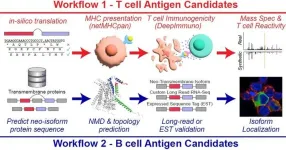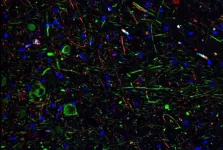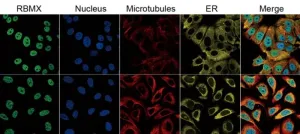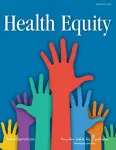(Press-News.org) An innovative computational tool dubbed “SNAF” may help the research world bring the emerging promise of cancer immunotherapy to a wider range of patients, according to a study published Jan. 17, 2024, in Science Translational Medicine.
The research tool, called the Splicing Neo Antigen Finder (SNAF), was developed by a multidisciplinary team of researchers from Cincinnati Children’s and the University of Virginia. The project was led by Guangyuan Li, PhD, and Nathan Salomonis, PhD, both with the Division of Biomedical Informatics at Cincinnati Children’s.
The co-authors say the tool has already helped uncover shared immunogenic targets across various cancers, which could pave the way for a new wave of highly focused cancer treatments.
"The implications of this discovery are significant," says H. Leighton “Lee” Grimes, PhD, a co-author of the study and director of the Cancer Pathology Program at Cincinnati Children’s. "By identifying shared splicing neoantigens present in up to 90% of cancer patients, SNAF not only presents new targets for therapy but also challenges and expands our understanding of cancer biology."
How the new tool finds new targets
Immunotherapy, which harnesses a patient’s immune system to fight cancer, often targets neoantigens produced from genetic mutations. However, this approach typically benefits only those with a high mutational burden. SNAF aims to expand the universe of immunotherapy by identifying neoantigens arising from post-transcriptional modifications, particularly splicing errors, which have been largely untapped until now.
Using new artificial intelligence approaches, SNAF predicts immunogenic peptides that T cells can recognize and novel proteins with altered extracellular components that B cells can target. This dual approach is vital in developing comprehensive immunotherapies that engage both arms of the adaptive immune system.
Promising target emerges for melanoma
While cataloging all possible neoantigens produced from alternative mRNA pathways, the team found that the amount of splicing neoantigens is correlated with patient survival and responses to immunotherapy in patients with melanoma.
One such prediction, SLC45A2, has emerged as a particularly promising target due to its high tumor specificity and immunogenicity.
In addition to T-cell neoantigens, the team has discovered a novel class of tumor-specific extracellular neo-epitopes, termed ExNeoEpitopes, through their B-cell focused pipeline, SNAF-B. These ExNeoEpitopes show great promise for the development of monoclonal antibodies and CAR-T cell therapies.
Next steps
"This is only the beginning," says Tamara Tilburgs, PhD, co-corresponding author and a researcher in the Division of Immunobiology. "The SNAF workflow’s flexibility means it can be continuously adapted as we make further inroads into understanding and combating cancer."
Salomonis and his team are now applying these tools in the most difficult-to-treat cancers to find the best targets for therapy development and understand their single-cell origins.
The research was supported by multiple grants, including the Cincinnati Children’s Hospital Research Foundation, the University of Cincinnati Cancer Center, the Melanoma Research Foundation, the American Cancer Society, and the National Institutes of Health (R01CA226802).
END
New research tool seeks to accelerate hunt for cancer immunotherapy targets
Experts from Cincinnati Children’s and the University of Virginia say the SNAF tool will tap into a wider universe of neoantigens to help a patient’s immune system fight cancer
2024-01-17
ELSE PRESS RELEASES FROM THIS DATE:
SARS-CoV-2 can infect dopamine neurons causing senescence
2024-01-17
A new study reported that SARS-CoV-2, the virus that causes COVID, can infect dopamine neurons in the brain and trigger senescence—when a cell loses the ability to grow and divide. The researchers from Weill Cornell Medicine, Memorial Sloan Kettering Cancer Center and Columbia University Vagelos College of Physicians and Surgeons suggest that further research on this finding may shed light on the neurological symptoms associated with long COVID such as brain fog, lethargy and depression.
The findings, published in Cell Stem Cell on Jan. 17, show that dopamine neurons infected with SARS-CoV-2 stop working and send out chemical signals that cause ...
The metalens meets the stars
2024-01-17
Metalenses have been used to image microscopic features of tissue and resolve details smaller than a wavelength of light. Now they are going bigger.
Researchers at the Harvard John A. Paulson School of Engineering and Applied Sciences (SEAS) have developed a 10-centimeter-diameter glass metalens that can image the sun, the moon and distant nebulae with high resolution. It is the first all-glass, large-scale metalens in the visible wavelength that can be mass produced using conventional CMOS fabrication technology.
The ...
New U of A-based study to examine very rare adverse events linked to COVID-19 vaccines
2024-01-17
EDMONTON — A University of Alberta professor is co-leading a new international vaccine safety network to examine why some people who received a COVID-19 vaccine experienced very rare adverse events associated with the vaccine.
The International Network of Special Immunization Services (INSIS), based at the U of A, is a consortium of academic medical centres around the world coming together to study very rare adverse events after vaccination. An adverse reaction is considered very rare when it affects less than .001 per cent of the population.
“The bar for safety with vaccines is very high because we’re giving them ...
$24 million grant to extend Study of Healthy Aging in African Americans (STAR)
2024-01-17
Researchers at UC Davis Health and Kaiser Permanente Division of Research have received a $24 million grant from the National Institute on Aging, part of the National Institutes of Health (NIH), to continue the Study of Healthy Aging in African Americans (STAR) for an additional five years.
STAR, which launched in 2017, follows a group of approximately 750 older adults to understand how behaviors and lifestyle may increase the risk of Alzheimer’s disease and related dementias for Black and African Americans. The study ...
Metastatic breast cancer treatments have aided decline in deaths, Stanford Medicine-led study finds
2024-01-17
Deaths from breast cancer dropped 58% between 1975 and 2019 due to a combination of screening mammography and improvements in treatment, according to a new multicenter study led by Stanford Medicine clinicians and biomedical data scientists.
Nearly one-third of the decrease (29%) is due to advances in treating metastatic breast cancer —a form that has spread to other areas of in the body and is known as stage 4 breast cancer or recurrent cancer. Although these advanced cancers are not considered curable, women with metastatic disease are living longer than ever.
The analysis helps cancer researchers assess where to focus future efforts and resources.
“We’ve ...
Aberrant RBMX expression relevant for cancer prognosis and immunotherapy response
2024-01-17
“In the future, targeting of RBMX may be a novel method in cancer therapy.”
BUFFALO, NY- January 17, 2024 – A new research paper was published in Aging (listed by MEDLINE/PubMed as "Aging (Albany NY)" and "Aging-US" by Web of Science) Volume 16, Issue 1, entitled, “Aberrant RBMX expression is relevant for cancer prognosis and immunotherapy response.”
Cancer accounts for the highest rates of morbidity and mortality worldwide. RNA binding motif protein X-linked (RBMX) is a nuclear ...
Higher measurement accuracy opens new window to the quantum world
2024-01-17
A team at HZB has developed a new measurement method that, for the first time, accurately detects tiny temperature differences in the range of 100 microkelvin in the thermal Hall effect. Previously, these temperature differences could not be measured quantitatively due to thermal noise. Using the well-known terbium titanate as an example, the team demonstrated that the method delivers highly reliable results. The thermal Hall effect provides information about coherent multi-particle states in quantum materials, based on their interaction with lattice vibrations (phonons).
The laws of quantum physics apply to all materials. However, in so-called ...
National collaborative for health equity roundtable: a call for unity and the power of racial healing
2024-01-17
A new Roundtable discussion in the peer-reviewed journal Health Equity explores the results of a poll conducted by the National Collaborative for Health Equity (NCHE), called the “Heart of America Annual Survey.” The survey found that more than 80% of respondents want a national leader that unifies rather than divides us, suggesting that there is a readiness in the country to put polarization and division behind us so that we can solve our collective and common challenges and problems. Click here to read the Roundtable now.
Moderating ...
New project to improve modeling of climate change
2024-01-17
Jingrui He, professor of information sciences at the University of Illinois Urbana-Champaign, has been awarded a two-year, $600,000 grant from the IBM-Illinois Discovery Accelerator Institute to improve modeling climate change and its impact across multiple application domains. He and a team of researchers from the University of Illinois and IBM will build Climate Runtime, a computational framework integrating cutting-edge capabilities from climate foundation models and multimodal fusion. This framework will allow for accurate prediction and quantification of weather and climate events and their impact in areas such as finance ...
Climate change isn’t producing expected increase in atmospheric moisture over dry regions
2024-01-17
Contacts:
David Hosansky, UCAR and NSF NCAR Manager of Media Relations
hosansky@ucar.edu
720-470-2073
Audrey Merket, UCAR and NSF NCAR Science Writer and Public Information Officer
amerket@ucar.edu
303-497-8293
The laws of thermodynamics dictate that a warmer atmosphere can hold more water vapor, but new research has found that atmospheric moisture has not increased as expected over arid and semi-arid regions of the world as the climate has warmed.
The findings are particularly puzzling because climate models have been predicting ...
LAST 30 PRESS RELEASES:
Scientists boost cell "powerhouses" to burn more calories
Automatic label checking: The missing step in making reliable medical AI
Low daily alcohol intake linked to 50% heightened mouth cancer risk in India
American Meteorological Society announces Rick Spinrad as 2026 President-Elect
Biomass-based carbon capture spotlighted in newly released global climate webinar recording
Illuminating invisible nano pollutants: advanced bioimaging tracks the full journey of emerging nanoscale contaminants in living systems
How does age affect recovery from spinal cord injury?
Novel AI tool offers prognosis for patients with head and neck cancer
Fathers’ microplastic exposure tied to their children’s metabolic problems
Research validates laboratory model for studying high-grade serous ovarian cancer
SIR 2026 delivers transformative breakthroughs in minimally invasive medicine to improve patient care
Stem Cell Reports most downloaded papers of 2025 highlight the breadth and impact of stem cell research
Oxford-led study estimates NHS spends around 3% of its primary and secondary care budget on the health impacts of heat and cold in England
A researcher’s long quest leads to a smart composite breakthrough
Urban wild bees act as “microbial sensors” of city health.
New study finds where you live affects recovery after a hip fracture
Forecasting the impact of fully automated vehicle adoption on US road traffic injuries
Alcohol-related hospitalizations from 2016 to 2022
Semaglutide and hospitalizations in patients with obesity and established cardiovascular disease
Researchers ‘listen in’ to embryo-mother interactions during implantation using a culture system replicating the womb lining
How changing your diet could help save the world
How to make AI truly scalable and reliable for real-time traffic assignment?
Beyond fragmented markets: A new framework for efficient and stable ride-pooling
Can shape priors make road perception more reliable for autonomous driving?
AI tracks nearly 100 years of aging research, revealing key trends and gaps
Innovative techniques enable Italy’s first imaging of individual trapped atoms
KIER successfully develops Korea-made “calibration thermoelectric module” for measuring thermoelectric device performance
Diversifying US Midwest farming for stability and resilience
Emphasizing immigrants’ deservingness shifts attitudes
Japanese eels, climate change, and river temperature
[Press-News.org] New research tool seeks to accelerate hunt for cancer immunotherapy targetsExperts from Cincinnati Children’s and the University of Virginia say the SNAF tool will tap into a wider universe of neoantigens to help a patient’s immune system fight cancer






